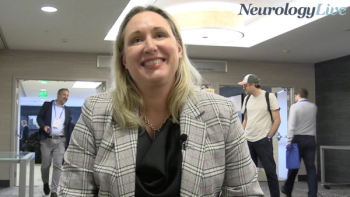
Analyzing Long-Term, End-Of-Study Results for Inebilizumab Treatment in NMOSD: Bruce Cree, MD, PhD, MAS, FAAN
The clinical research director of the UCSF Multiple Sclerosis Center discussed findings from the end-of-study analysis assessing inebilizumab which revealed a significant reduction in attack rates among patients with NMOSD over time. [WATCH TIME: 3 minutes]
WATCH TIME: 3 minutes
"It’s very interesting observation because it speaks to a biological impact of long-term B cell depletion in NMO (neuromyelitis optica) and resonates with the clinical experience that many of us have had when we have treated patients with other B-cell depleting therapies such as rituximab: once patients stabilized on treatment they tend to stay stable on treatment over the long term."
Inebilizumab (Uplizna; Amgen), an FDA-approved anti-CD19 B-cell-depleting antibody, has shown sustained efficacy and safety in patients with neuromyelitis optica spectrum disorder (NMOSD) according to newly published end-of-study results from the phase 2/3 N-MOmentum trial (NCT02200770). The end-of-study analysis of N-MOmentum, which included both the randomized controlled period and the open-label extension period, confirmed the long-term clinical benefits of inebilizumab treatment in patients with NMOSD.
In the trial, led by
The end-of-study analysis focused on time to adjudicated attack, annualized attack rate, and safety outcomes. Results showed that adjudicated NMOSD attacks occurred in 21% of treated patients (n = 225), with 63% of these attacks occurring in the first year of treatment. Of the patients who experienced an adjudicated attack while on inebilizumab, 77% (36 out of 47 patients) were attack-free by the end of 4 years. In terms of safety, 92% of treated patients reported at least 1 treatment-emergent adverse event (TEAE). The most common AEs were urinary tract infection, nasopharyngitis, and arthralgia.
In a recent interview, Cree, the clinical research director of the UCSF Multiple Sclerosis Center, sat down with NeurologyLive® to discuss the significance of the changing hazard ratio for NMOSD attacks seen over time in the end-of-study analysis of N-MOmentum. He also spoke about how long-term B cell depletion therapy compares with other treatments like rituximab in terms of stability for patients with NMOSD. Furthermore, Cree shared some of the recommended practices for monitoring immunoglobulin G levels in patients undergoing B cell depleting therapy in clinical practice.
REFERENCES
1. Cree BAC, Kim HJ, Weinshenker BG, et al. Safety and efficacy of inebilizumab for the treatment of neuromyelitis optica spectrum disorder: end-of-study results from the open-label period of the N-MOmentum trial. Lancet Neurol. 2024;23(6):588-602. doi:10.1016/S1474-4422(24)00077-2
Newsletter
Keep your finger on the pulse of neurology—subscribe to NeurologyLive for expert interviews, new data, and breakthrough treatment updates.




































